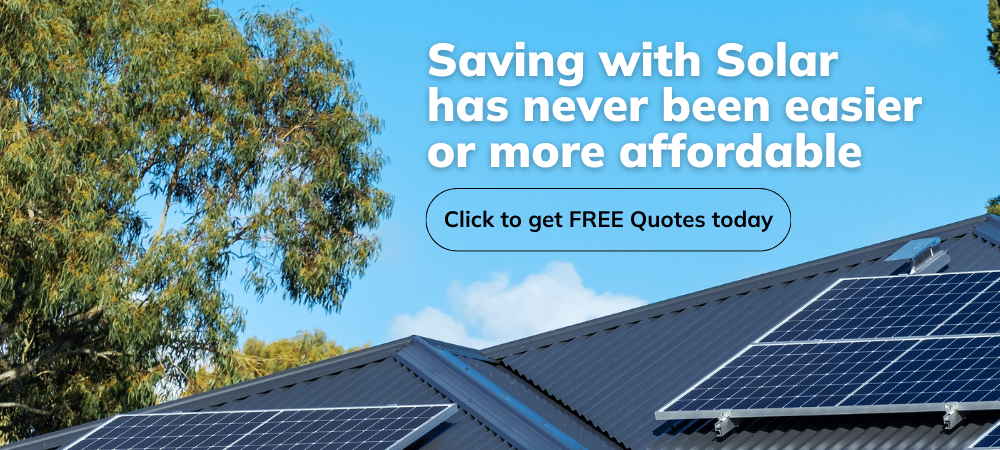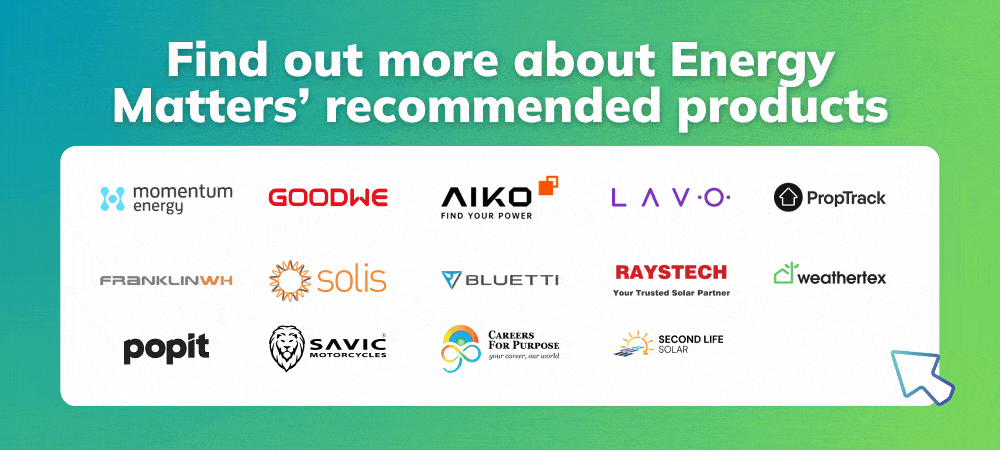The size or dimensions of the solar panels, measured in height by width, will determine the number of solar panels that will fit on your roof and the wattage of solar panels installed. And the power produced or wattage (measured in Watts or W) by the solar PV system depends on the number of solar panels installed.
- The solar panel dimensions are measured in height x width in metres or centimetres, which play a crucial role in determining the size of the solar panel.
- The maximum power output of the panel – measured in watts, or ‘W.’
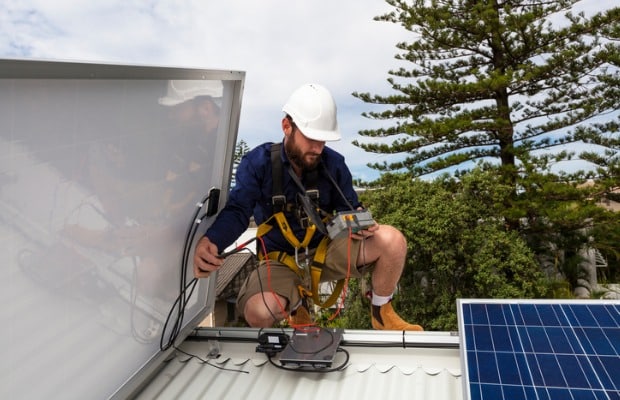
On this page
Understanding the output of a standard solar panel
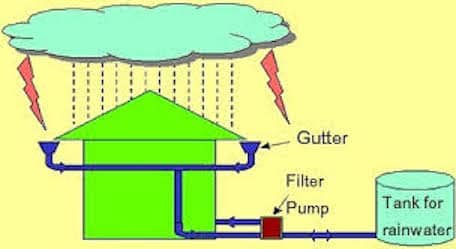

Using the analogy of a rainwater system and a solar installation is an excellent approach to comprehending electricity and solar panel sizing. Consider a solar panel as the water tank, and the roof of a home as the water collection system. More solar panels with higher watt ratings may provide more power, and larger roofs can collect more water.
Through a pipe that connects the water tank to the roof, water flows from the roof into the gutters and finally into the pipe. As more water is concentrated in a smaller space—imagine a funnel—pressure increases. The water pressure from the roof represents voltage, and amps are represented by the water flowing through the tank’s pipe.
Similarly, the wattage of solar panels increases as more panels are installed in a given space, resulting in higher power output.
Using the same analogy, we will draw water from a tap at the tank’s base. When the tank fills up, we will have higher water pressure coming out of this tap.
The quantity of DC (direct current) power each solar panel can generate under typical test conditions determines its rating, including the wattage of solar panels. The power generated by a solar panel is measured in watts (W), which correspond to the panel’s optimum sunshine and temperature conditions. Volts and amps are multiplied to determine wattage, where volts denote the electrical force and amperes (amps) the total energy used.
Watts is the power produced by the solar panel, with the entire panel’s wattage capable of being obtained in ideal conditions (A solar panel at the optimal temperature and in perfect alignment with perfect sunlight).
Similarly, it can measure the power flowing out of the battery in watts, providing valuable information about energy usage.
Volts are the pressure of electricity produced by the solar panel, analogous to the height of water held in a water tank: the higher the water tank, the greater the water pressure.
Amps are the amount of electricity that flows via the solar panel and connections. It is referred to as flow current, comparable to the amount of water flowing into and out of a water tank.
Because different states and regions in Australia receive different hours of sunlight, the outputs for the panel may differ according to the location of the installation. The wattage of solar panels plays a key role in determining the power they can generate, with greater sunlight absorption leading to better power generation.
Understanding your electricity usage
Watt (W) and kilowatt (kw): units used to quantify the rate of energy transfer. One kilowatt = 1000 watts. Solar panels’ rating in watts specifies the maximum power the solar panel can deliver at any time, providing insights into their capacity.
Watt-hours (Wh) and kilowatt-hours (kWh): a measure of energy production or consumption over time. The actual amount of electricity generated per kilowatt-hour (kWh) is the unit you’ll see on your electricity bill. The wattage of solar panels directly affects kilowatt-hour (kWh) production, making it necessary to consider the wattage of solar panels for accurate system sizing. Check out our page to learn more about the difference between W, kW and kWh.
1 kW of solar panels = 4 kWh of electricity produced per day (roughly).
For instance, each kW of solar panels will generate around 4 kWh of electricity per day. On a good day, a 6.6 kW solar system, which takes into account the wattage of solar panels, will create approximately 26.4 kWh. The amount of electricity generated per kW of solar panels varies depending on location, time of year, sunlight exposure, system quality, panel orientation, age and other factors.
It could be as low as 3.5 kWh per day in southern regions like Hobart, while the same 1 kW of panels in Darwin could generate 5 kWh.
How many solar panels will I need?
Your daily energy consumption and the size of your solar system determine the number of solar panels required for your home. The more solar panels you require, the larger your solar system will be. The table below is a guideline based on 330W panels.
Solar panel size and wattage
Solar panels are different models of capturing and producing electricity. For instance, residential solar uses a 6.6 kW system.
The number of solar panels x output = Solar system size
20 x 330W panels = 6,600 W or 6.6kW solar system
The number of solar panels multiplied by their output determines the size of the solar system. For example, if you have 20 solar panels with a wattage of 330W each, it results in a 6,600 W or 6.6kW solar system.
The wattage of the solar panels, in this case, is crucial in determining the overall capacity of the system.
Your system may consist of 20x330W panels, resulting in a 6,600W (6.6kW) solar PV system.
A solar photovoltaic (PV) system’s size or capacity is the maximum amount of electricity it can produce. It isn’t about the number of solar panels but the system’s overall capacity.
The standard of solar panel size in Australia
When considering a solar panel’s or system’s size, three things are cited:
- The physical size of the solar panel
- The size in Watts or output of the solar panels
- The combined output of a solar system in Kilowatts
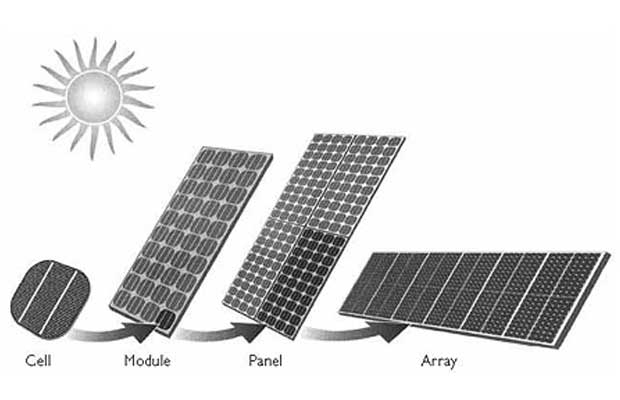
Image: Saur Energy International
Traditionally, solar panels can be categorised into two sizes: 60-cell and 72-cell solar panels. The size in watts corresponds to their physical dimensions and power output. For example, 60-cell solar panels measure 99 x 167.6 cm and produce 270 to 300 watts, while 72-cell solar panels have an average output ranging between 350 and 400 watts due to the extra row of cells.
Half-cut solar panels
Half cut cell panels appeared and these half-cell panels have been cut in half.
The panel’s output remains unchanged, but the electrical resistance in each cell is reduced, resulting in an efficiency gain. This is the standard technology in most contemporary solar panel products.
For much of the last decade, the industry-standard panel size was 156mm x 156mm or 6-inch square cell format. The new panel sizes, up to 2.4m long and 1.3m broad, are based on the larger 180 and 210mm wafer (based silicon cells are fabricated from slices of either single-crystal or multi-crystalline silicon) sizes. This is a size increase of 20% to 30% above standard 2.0m x 1.0m 72-cell panels, which naturally corresponds to a significant increase in power per panel.
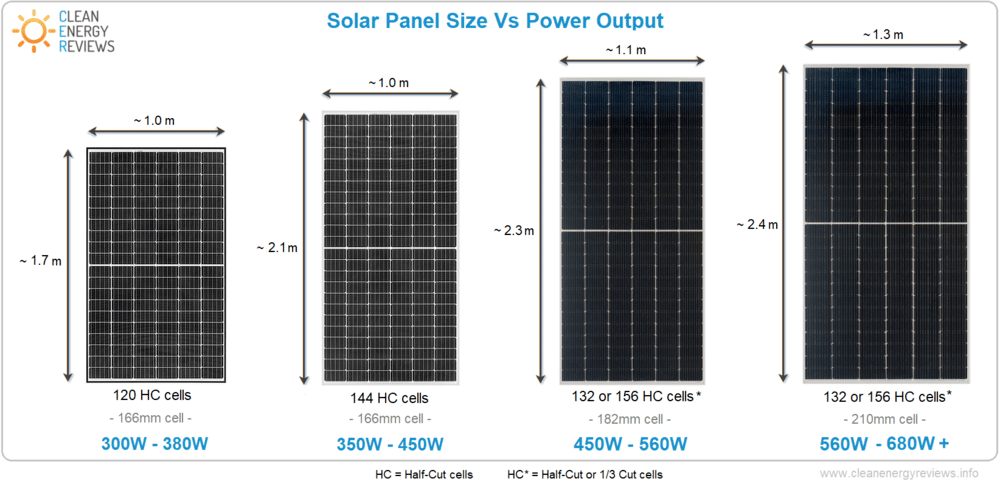
Important things to consider in solar panel size
Important things to consider when sizing your solar PV system include understanding the wattage of solar panels and the concept of solar panel sizing. You can only properly size your solar PV system once you know how much electricity your home consumes. The simplest approach is to examine prior electricity bills, which should show how much power you consumed in the previous month or quarter. It allows you to calculate the average daily usage. You should be able to monitor your daily bill usage or log into your account online.
Seasonal and time of day usage
It is critical to consider when you use electricity. Is your house usually empty throughout the week, with everyone at work or school, so your biggest power use occurs in the evening? If this is the case, your solar panels may not be used to their full potential, as it is preferable to consume the generated power during the day (or to charge a storage battery) rather than export it to the grid.
Consider whether some days are more resource than others, such as the weekend, when everyone is at home. And do you use more power in the summer (when you use air conditioners) or in the winter (when you run heaters)?
Put all of this together, and you should have a fair idea of how much power you typically use each day, how much you use on peak days, and when you use the most power.
Future usage
Because your solar PV system will hopefully be on your roof for many years, you should predict how much electricity you’ll require. Consider the following future requirements:

- Acquiring an electric vehicle
- Working from home more frequently, and so using more electricity at home
- Planning to start a family
- Adding a swimming pool (pool pumps can use a lot of power)
- Switching from gas hot water and cooking to electric
- Increasing the resale value of the house.
Can my roof support the weight of solar panels?
It will be determined by the material and integrity of the roof, available roof space, the weight of the solar panels, and constraints imposed by your energy retailer. Modern homes can support more than 14 to 20kg of weight per square metre. Roofs that are maintained can carry about 18 kg of typical solar cells. Roofs that are maintained can contain a solar panel, but some roofs are not permitted to have a solar panel.
Installed solar panels typically have to be examined by the installer before installation. Many older buildings can’t bear the weight of solar panels, so it’s a good idea to ask your solar installer to come to your home and see how much the structure can support.
Understanding solar panel installation costs in Australia
When considering the best solar panel sizes and wattage for your home, it is essential to understand the associated installation costs. Pricing can vary depending on the selected solar panel size and roof structure, and whether you choose premium wattage or more compact dimensions. To make an informed decision and budget accordingly, explore our detailed breakdown of solar panel installation costs to understand the factors that influence the overall expense of a solar system in Australia.
Distribution Network Service Provider (DNSP)
The network owners that distribute electricity, known as the Distribution Network Service Provider (DNSP) or simply the distributor, choose to limit the number of solar panels and inverters that can install in your home, not the energy retailer.
Most single-phase residences are limited to a 5kW inverter and 6.6kW solar panels. Despite this, some households can have up to 10kW, and three-phase homes can have up to 30kW.
Solar output is limited since electricity distribution networks were initially designed so that power is only pushed in one direction and at a predictable rate. When customers became producers who sought to pump energy into the network as wind and solar became more popular, it disrupted the network concept.
Despite the green energy revolution, distributors are concerned that too much electricity streaming into the grid would cause older power plants to fail. The grid must maintain a constant voltage. Excessive solar input or feed-in raises the voltage.
To understand the specific guidelines for rooftop solar power installation in your state, you can visit our page for state-by-state guidelines.
Additionally, check out our tips for selecting a solar power system or choosing the right solar panels.
Energy Matters has been a leader in the renewable energy industry since 2005 and has helped over 40,000 Australian households in their journey to energy independence.
Let us discuss and choose the best quote that suits your needs and budget, and we can connect you with our trusted local installers, who will provide up to 3 FREE quotes for your home and business solar energy system. Complete our quick quiz and begin your solar journey today!











